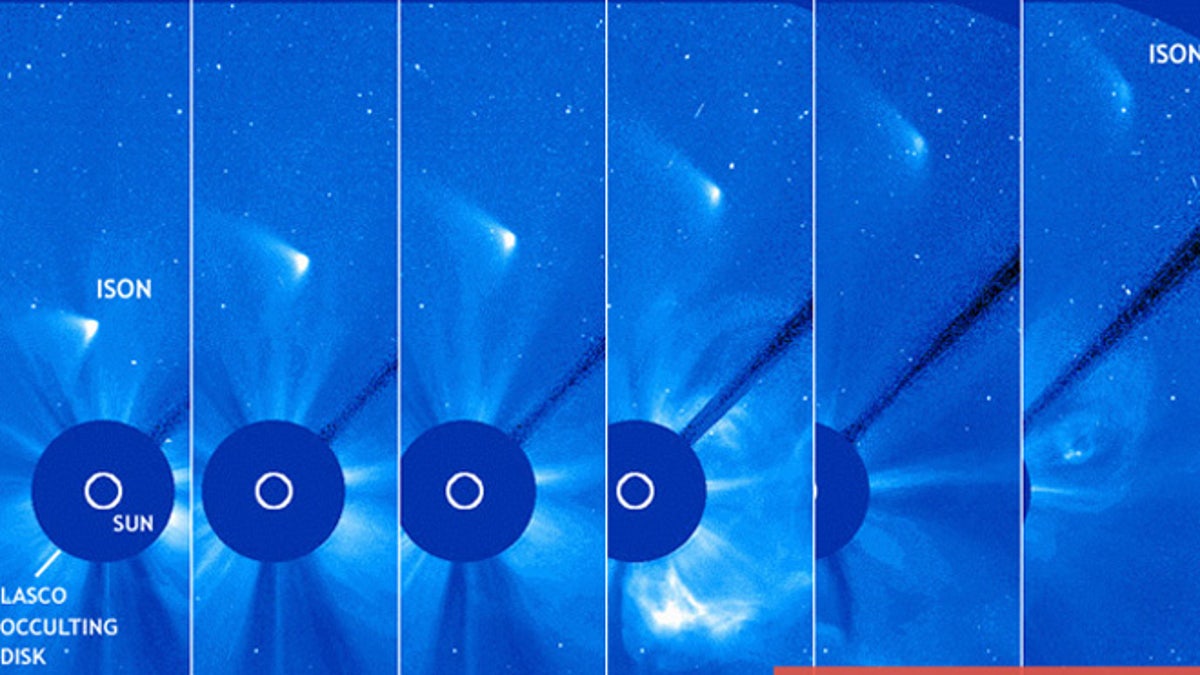
(NASA/ESA)
Sad news, comet fans: ISON is no more. It’s a vaporized husk of its former self. A sublimated dirty snowball. Comet ISON is an ex-comet and this time it’s not playing.
This sad turn of events is brought to you by the joint NASA/ESA Solar and Heliospheric Observatory (SoHO)’s LASCO instrument that gives a wide-angle view of the sun’s atmosphere (pictured above). For the duration of Comet ISON’s close approach to our nearest star, LASCO has been carefully tracking the comet’s progress. After many heart-stopping hours post-perihelion on Nov. 28, space experts nearly gave up hope — ISON had vanished from LASCO’s view, apparently not surviving he sun’s extreme tidal forces and powerful radiation.
[pullquote]
But then, just as the U.S. was recovering from Thanksgiving turkey and wine, ISON re-energized; a component of its roasted nucleus had survived the turmoil and was brightening.
ANALYSIS: All Eyes on ISON as ‘Phoenix’ Comet Rises from Ashes
- Close-Up Photos of a Snowstorm-Spewing Comet
- NASA’s Stardust Spaceship Takes High-Res Photos of Comet Tempel 1
- China launches first moon rover mission
- Japanese firm proposes building solar panel ring around moon
- 8 best Cyber Monday tech deals
- 300-pound robot is new breed of crime-fighting machine
- In pictures: ISON, ‘comet of the century’ no more?
Unfortunately, the brightening was short-lived. Despite a couple of days of hope, Comet ISON’s nucleus has all but disappeared leaving a ghostly wisp of dust behind.
The “Comet of the Century” is now, officially, the Turkey of the Century.
“Among experts, a consensus is building that the comet broke apart shortly before perihelion (closest approach to the sun),” writes Tony Phillips, NASA astronomer and curator of Spaceweather.com.
ANALYSIS: Comet ISON Barely Survives Thanksgiving Solar Roast
Like the countless sungrazing comets that have come before it, ISON succumbed to the close solar pass. Although hopes were high that the comet would survive the plunge, no one really knew what ISON was going to do. As a “virgin” comet from the Oort Cloud (a hypothetical cloud of cometary objects approximately one light-year from the sun), this was ISON’s fist visit to the inner solar system. With little information on the comet’s composition, cometary fragmentation was always a possibility.
Comet ISON: 5 Things You Should Know
All that remains of Comet ISON seems to be a fan-shaped debris field of small fragments of the once-mighty cometary nucleus, each shard frantically venting the remaining ices into space. Any hope of seeing a dazzling naked-eye comet just in time for Christmas is vaporizing faster than the sublimating ISON fragments that now litter interplanetary space.